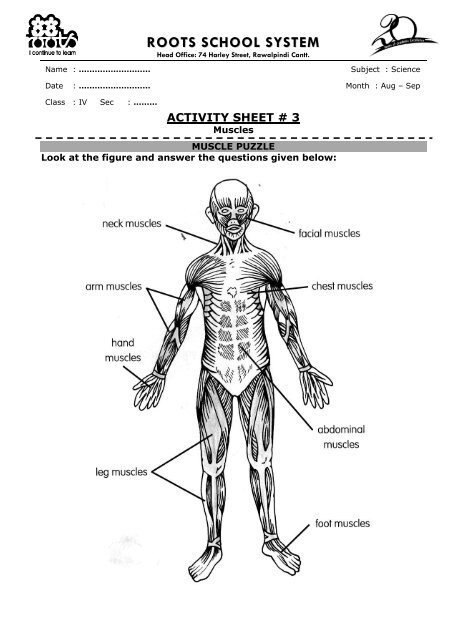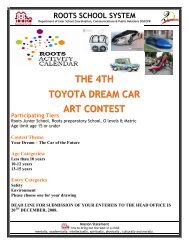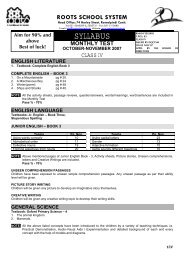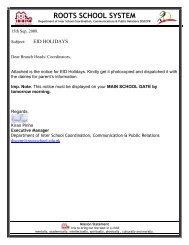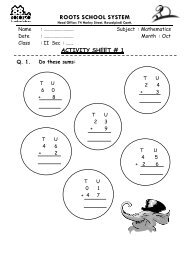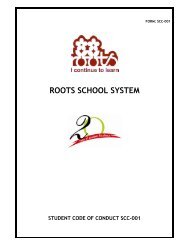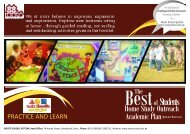Science - Roots School System
Science - Roots School System
Science - Roots School System
You also want an ePaper? Increase the reach of your titles
YUMPU automatically turns print PDFs into web optimized ePapers that Google loves.
Name : ………………………<br />
ROOTS SCHOOL SYSTEM<br />
Head Office: 74 Harley Street, Rawalpindi Cantt.<br />
Subject : <strong>Science</strong><br />
Date : ……………………… Month : Aug – Sep<br />
Class : IV Sec : ………<br />
ACTIVITY SHEET # 3<br />
Muscles<br />
MUSCLE PUZZLE<br />
Look at the figure and answer the questions given below:
Activity Sheet # 3, Aug – Sep<br />
1. Which muscles do you use when you smile?<br />
……………………………………………………………………………………………………..<br />
2. Which muscles allow you to turn your head?<br />
……………………………………………………………………………………………………..<br />
3. Name two actions you can do with your leg muscle.<br />
(a) ………………………………………………………………………………………………<br />
(b) ………………………………………………………………………………………………<br />
4. Name two actions you can do with your arm and hand muscles<br />
(a) ………………………………………………………………………………………………<br />
(b) ………………………………………………………………………………………………<br />
5. When you breathe in and out, which muscles are you using?<br />
……………………………………………………………………………………………………..
ROOTS SCHOOL SYSTEM<br />
Head Office: 74 Harley Street, Rawalpindi Cantt.<br />
Name : ………………………<br />
Subject : <strong>Science</strong><br />
Date : ……………………… Month : Oct<br />
Class : IV Sec : ………<br />
ACTIVITY SHEET # 1<br />
The Ear<br />
HOW YOU HEAR:<br />
Clap your hands. You hear the sound of the clap with your ears. The sound moves<br />
very fast. Each part of your ear helps you to hear the sound of the clap.<br />
The outer ear gathers the sound and moves it into the ear canal. Then the sound<br />
hits the eardrum. The eardrum moves very fast. It vibrates.<br />
This makes the small bones in the middle ear vibrate. The oval window also moves<br />
very fast. This vibration is transferred to the hair cells in the cochlea.<br />
Then something very special happens. The hair cells change the clapping sound to<br />
a kind of electricity. The electricity moves up the auditory nerve to your brain. You<br />
hear the clapping sound when the electricity gets to your brain.<br />
Look at the picture. It shows what happens to the clapping sound. It happens very<br />
fast.<br />
Fill in the blanks with suitable words given below:<br />
1. The ear has ………………………… parts.<br />
2. The outer ear stops at the …………………………<br />
3. The middle ear has ………………………… small bones.<br />
4. They are called the …………………………, the …………………………, and the<br />
…………………………<br />
WORD BANK<br />
3, stirrup, hammer,<br />
cochlea, liquid, vibrate,<br />
anvil, eardrum, 3<br />
5. The small bones in the middle ear move very fast. They …………………………
Activity Sheet # 1, Oct<br />
6. The ………………………… is shaped like a snail's shell.<br />
7. The cochlea is filled with …………………………<br />
HEARING LOSS:<br />
Some people can not hear well as others do. They have a hearing loss. There are<br />
many reasons for hearing loss. Some of these reasons are:<br />
• Sickness — Sometimes getting measles or mumps can cause hearing loss.<br />
• Accidents — Sometimes getting hit on the head can cause hearing loss.<br />
• Loud Noises — Sometimes loud noises can cause hearing loss. Listening to loud<br />
music, guns shooting, or firecrackers can cause hearing loss.<br />
• Inherited Hearing Loss — Sometimes several people in a family have a hearing<br />
loss. Sometimes hearing loss can be inherited from a father, a mother, or some<br />
other relative in the family.<br />
FIND THE WORDS:<br />
Names of parts of the ear and words about hearing are hidden in the puzzle. Find<br />
the twelve words and circle them.<br />
Ear Eardrum Pinna Noise<br />
Anvil Hair cells Hammer Cochlea<br />
Canal Stirrup Brain Inner Ear
ROOTS SCHOOL SYSTEM<br />
Head Office: 74 Harley Street, Rawalpindi Cantt.<br />
Name : ……………………… Subject : <strong>Science</strong><br />
Date : ……………………… Month : Oct<br />
Class : IV Sec : ………<br />
ACTIVITY SHEET # 2<br />
The Egg<br />
EGG PARTS<br />
Colour each part of the egg a different colour and label each part.<br />
WORD BANK<br />
shell, yolk, air<br />
sac, membrane,<br />
albumen<br />
EGG GRADING<br />
Match the egg to its grade. Eggs are graded for quality. Read the description of<br />
each grade of egg<br />
carefully and then grade<br />
each egg in the box with<br />
AA, A, or B.<br />
A grade AA egg stands up<br />
tall. The yolk is firm and<br />
the area covered by white<br />
is small.<br />
A grade A egg has a yolk<br />
that is round and tall. The<br />
white is a little flatter<br />
than a grade AA egg.<br />
A grade B egg spreads<br />
out more. The yolk is<br />
flattened.<br />
The grades of eggs can change if eggs are not stored correctly or if eggs are kept<br />
for a long time in the refrigerator.
Activity Sheet # 2, Oct<br />
UNSCRAMBLE THE SCRAMBLED EGGS<br />
1. ………………………………..... 2. ……………………………….....<br />
3. ………………………………..... 4. ……………………………….....<br />
5. ………………………………..... 6. ……………………………….....<br />
7. ………………………………..... 8. ……………………………….....<br />
EGG VOCABULARY<br />
PUT THESE WORDS IN ALPHABETICAL ORDER:<br />
hatch<br />
egg<br />
yolk<br />
shell<br />
chicken<br />
embryo<br />
fertilized<br />
nest<br />
albumen<br />
sticky<br />
1. ………………<br />
2. ………………<br />
3. ………………<br />
4. ………………<br />
5. ………………<br />
6. ………………<br />
7. ………………<br />
8. ………………<br />
9. ………………<br />
10. ………………


